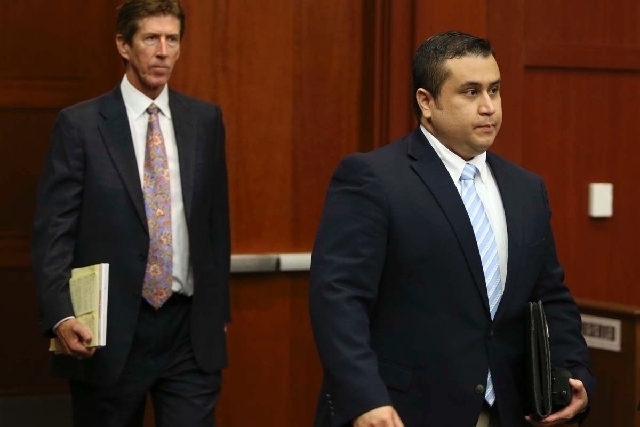CNN, HLN televising dueling Zimmerman trial shows

NEW YORK — HLN network chief executive Scot Safon resisted any impulse to call his counterpart at CNN, Jeff Zucker, to say “What are you doing to me?” when he learned that CNN scheduled a nightly hour on the George Zimmerman murder trial for the same time HLN was airing one.
So far, the call hasn’t been necessary.
The CNN sister networks did well the first few nights they competed against each other to recap events in the Florida trial in which neighborhood watch volunteer Zimmerman is accused of murder in the shooting of unarmed teenager Trayvon Martin. Zimmerman says he acted in self-defense.
Focus on the Zimmerman trial fit naturally in the 10 p.m. Eastern timeslot that HLN (formerly CNN Headline News) is using for “After Dark,” a show that started this spring to cover the Jodi Arias murder trial. It was such a success that it attracted the attention of CNN, which has been actively searching for something new to put on at 10 p.m.
“If someone else is doing it, I would rather have them doing it,” Safon said. “I work for CNN.”
Although he didn’t initiate any corporate battle over CNN’s “Self Defense or Murder?” show, “I looked at it very carefully,” Safon said.
During its first four days on the air, CNN’s “Self Defense or Murder?” averaged 597,000 viewers, the Nielsen Co. said. That was up 41 percent from what it had been averaging at that time on Mondays through Thursdays during the previous month and instantly made it the network’s most popular show in prime time.
HLN’s “After Dark” averaged 463,000 viewers on Monday through Thursday, up 55 percent from its average over the past month though below its peak during the Arias trial, Nielsen said.
The CNN networks aren’t the only ones noticing the public interest: MSNBC hastily scheduled a one-hour Zimmerman trial special Friday at 10 p.m. to review the week’s events, and it plans to do that once a week for the trial’s duration.
CNN has been testing different formats for its 10 p.m. hour, which has essentially been filled with either a repeat of Anderson Cooper’s 8 p.m. newscast or, on busy nights, a new one. Cooper has been involved in some of the experiments and hosted “Self Defense or Murder?”
Scheduled initially as a one-week test, the Zimmerman-focused hour is expected to continue because the ratings are so strong. CNN declined a request to have an executive talk about their plans.
“At times I wish we were not talking about the exact same stories,” Safon said. But he noted that the two programs are different in their approaches and play to the strength of each network.
The Cooper-anchored hour on CNN is a more sober recap of the events while “After Dark” is more stylized. The show’s format is to have a dozen members of the public acting as the jury while lawyers familiar with the case argue both sides of a particular issue addressed in that day’s testimony.
HLN gave birth to “After Dark” in much the same fashion as ABC’s “Nightline” was invented more than three decades ago. Both shows started as a way to provide extra coverage of an ongoing story — for “Nightline,” it was the Iranian hostage crisis of 1979-81 — and continued after the initial story ended.
Until this spring, HLN aired a rerun of Nancy Grace’s 8 p.m. ET show at 10. But network executives looked for a way to prolong its coverage of Arias, a woman convicted of stabbing and shooting her on-again, off-again boyfriend in suburban Phoenix, when her trial proved popular and lengthy. Why not give a forum to the experts hired by the network to talk about the Arias case, since they loved to talk about it after hours anyway?
“It was a show that was ruled by the enthusiasm that everyone had for the story that they were covering,” Safon said.
In addition to heavily caffeinated lawyers, the “jury” offers a way to bring in members of the public who are following the case closely. Producers had initially considered having a studio audience.
Trials are by nature theatrical, Safon said. He wanted a show that would reflect that, one that was lively and engaging but not descend into silliness.
During the last four weeks of the Arias trial, which ended May 8, the “After Dark” recap averaged 616,000 viewers each weeknight, more than double the 244,000 who watched a Grace rerun during the same period in 2012, Nielsen said.
Until a week before the end of the trial, HLN did not know whether its show was temporary. It was decided the same format could be used for other high-profile trials or, in the absence of any, to debate other public issues, Safon said. “After Dark” subject matter has also taken on Lance Armstrong and his use of performance-enhancing drugs and the troubles involving the late Michael Jackson.
Producers are keeping their eyes open for other trials that might trigger a soap opera-like interest among viewers.
“The conclusion that we came to is that there is always stuff happening in the court of public opinion,” Safon said.












